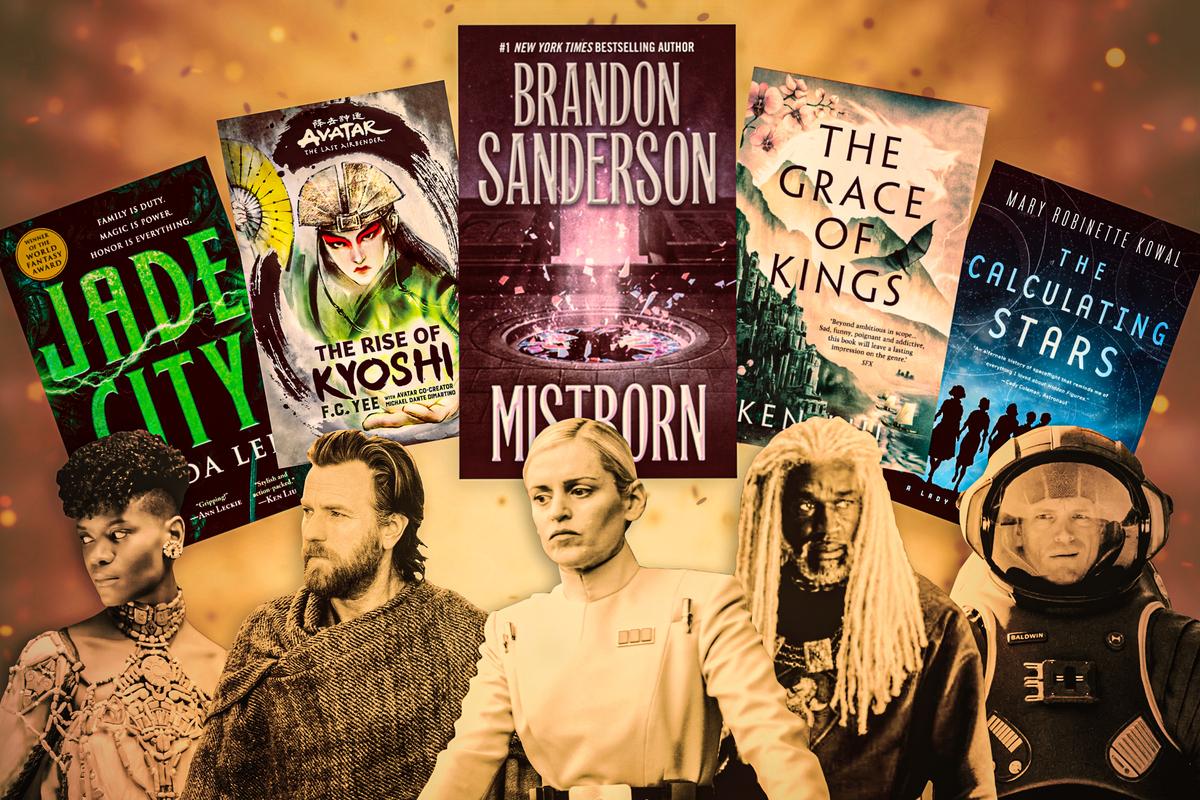
The domain of so-called nerd culture keeps expanding in Hollywood, and viewers who enjoy superheroes, magic, and space were inundated with movies and TV shows that catered to their interests in 2022. As Marvel and Star Wars expand their weekly offerings and as non-Disney studios pursue projects once considered “unfilmable,” it’s all a sci-fi/fantasy geek can do to stay up to date with all the genre’s offerings.
The screen isn’t the only medium where those fans can consume stories. The page overflows as well. But where to begin?
I’m here to help fans who want to dip their toes into the genre’s best books that haven’t been adapted (yet). But this isn’t just a straight top 10 list. Rather, as 2022 comes to a close, I’ve curated a recommended reading guide for viewers of many of the year’s biggest on-screen properties, a sort of if you liked Show X or Movie Y, try reading Book Z endeavor. And for more recs—across mediums—check out the latest episode of House of R, which features assorted suggestions from colleagues and Ringer friends.
If you watched Black Panther: Wakanda Forever, read The Green Bone Saga by Fonda Lee
An isolated nation holds a monopoly on the world’s most powerful substance—a kind of rock that can grant its holder superpowers when it is fashioned into weapons, medical technology, or pure decoration. The protagonists must contend with a rival that has its own hold on the superpower supply, as well as with the rest of the world, which wants access to the forbidden powers.
That description applies to the Black Panther sequel, which features vibranium as the ore in question; it also applies to Lee’s magnificent Green Bone trilogy, my favorite read of 2022, which starts with the novel Jade City as the green mineral jade takes center stage.
Wakanda Forever meandered in places but was strongest in three areas: First, it developed distinct cultures and places through both the expansion of Wakanda and the introduction of Talokan; second, it managed loss and grief with empathy and care; and third, it staged a philosophical argument about what a group with a monopoly on power owes to the rest of the world.
Green Bone—which is often described as a blend of kung fu and Godfather-esque mafia tropes—doesn’t just check off all those boxes; it excels at each element. Over the course of the decades the series spans, readers follow members of the Kaul family, one of the ruling clans on the jade-rich island of Kekon, as they combat both internal and external threats to their way of life. The story is incredible in all facets: incredible character arcs for the Kauls, incredible pacing for its plot, incredible world building in Kekon and beyond. It even has an incredibly compelling villain like Wakanda Forever’s Namor, appropriately fearsome but relatable enough to retain shades of gray.
Moreover, unlike many classical fantasy stories, Lee’s saga belongs in the urban fantasy subgenre, which means it takes place in a more modern world with telephones, airplanes, and the like. Thus, readers can see how her story’s superpowers interact with contemporary technology, just as in the Marvel Cinematic Universe.
If you watched Obi-Wan Kenobi, read The Rise of Kyoshi by F.C. Yee
I was disappointed by the much-anticipated Obi-Wan show, as well as by the parts of The Book of Boba Fett that I watched. But if you want an example of IP nostalgia done right, read the first of the Kyoshi books, set in the universe of Avatar: The Last Airbender. Well, if you haven’t seen that show, watch it first because it’s excellent even for adults. And if you have seen it, then you’re sure to like this prequel story as well.
ATLA viewers already know a bit about Kyoshi: The Earth-born avatar is the namesake of the Kyoshi Warriors, and she appears a few times on-screen to impart advice to Aang and, on one notable occasion, testify in a murder trial. And in this book—which is part of the ATLA universe canon, with the stamp of approval of the show’s creators—we learn about her journey from orphaned child to feared avatar.
The Rise of Kyoshi isn’t just a retread of the same story beats we’ve seen before; while it includes some Easter eggs for fans, like a role for the Beifong family and a return of the shirshu tracker, it adds to the lore and expands the world in ways that, frankly, I’d hoped Obi-Wan Kenobi would do better. Readers can observe the Earth Kingdom at the height of its power, delight in new and inventive bending techniques, and shudder at the violent, gnarly deaths that populate its pages.
This book also has a sequel, which I thought was only OK. Yee has since moved on to the Air-born avatar Yangchen as he continues his work in this fictional universe.
If you watched Andor, read Mistborn by Brandon Sanderson
Published in 2006, Mistborn (also called The Final Empire in some editions) is the oldest recommendation on this list, but it’s the right fit: Andor was the best show of the year, so it deserves an appropriately grand recommendation.
And Mistborn matches Andor’s vibe in so many ways that I had to include it here. Are you interested in a story about an evil empire that’s led by a ruler with magical powers and that lords over a beaten-down populace? And would you like to follow an outcast with a special spark who’s recruited by a ragtag rebellion to participate in a heist that can help bring down that empire? And what about a side plot that takes place in high society, where a character must mask her true feelings while making clandestine contributions to the rebellion?
Even casual sci-fi/fantasy fans might know Sanderson’s name because of his work finishing the Wheel of Time series or his immense publishing success. He deserves the hype for his winning characters, expansive worlds, and propulsive plots. And while Mistborn includes a lot more magic than Andor—which, in a pleasant reprieve from most Star Wars fare, included nary a lightsaber or Force jump—it has a hard magic system, meaning a more grounded magical setup with rules and restrictions (as opposed to a soft magic system, as in The Lord of the Rings).
Now’s as good a time as any to start reading Sanderson if you haven’t tried before. If you like Mistborn, you can use it as a gateway to the whole interconnected world of Sanderson books, and adaptations of his work will probably reach screens at some point soon.
If you watched For All Mankind, read the Lady Astronaut series by Mary Robinette Kowal
The Apple TV+ astronaut show isn’t a Disney property, but who cares—now three seasons in, it’s the best non-Andor genre show around. And it finds a perfect companion in Lady Astronaut—a trilogy (for now) that starts with The Calculating Stars—as both series are alternate-history vehicles centered on an accelerated space race in the mid-20th century.
For FAM, the inciting incident is the Soviet Union’s arrival on the moon before Neil Armstrong and the Americans can plant their capitalist flag. For Lady Astronaut, it’s a massive meteor that devastates a huge chunk of North America and alters the planet’s climate so severely that humankind must turn its eyes to the stars.
Elma York is the eponymous lady astronaut, a pilot and mathematician who wants to be a pioneer in space, and she’s just as creative and charismatic as any of the many protagonists who populate FAM’s large cast. She’s a bit Tracy Stevens, a bit Margo Madison, a bit Danielle Poole. And while FAM may have reached Mars in Season 3, Elma York pursued that goal even earlier than the show’s astronauts did in her world’s timeline of solar system exploration.
If you watched The Boys or She-Hulk: Attorney at Law, read Hench by Natalie Zina Walschots
Hench starts with a delightful premise: A supervillain has to hire a lot of employees, and not all of them can be true believers in the cause. Instead, this world has a temp agency for all the secretaries, janitors, and data analysts necessary to keep a proper secret lair up and running.
The main character is Anna Tromedlov (read her surname backward), who takes jobs as a freelance henchwoman to make ends meet. She’s not a supervillain, and she doesn’t want to be. But her perspective changes after a run-of-the-mill day goes awry and Supercollider—this world’s version of Superman or Homelander—breaks her leg on a mission. This is a familiar theme, Boys viewers: Anna realizes how much collateral damage superheroes inflict.
Hench isn’t a flawless book; in particular, I thought that the final third underwhelmed. But its premise is so strong, its humor so incisive, and its actually, superheroes would cause tremendous damage to ordinary people philosophy so aligned with The Boys that it’s an ideal fit for this list.
That tongue-in-cheek superhero humor also makes it a worthwhile companion to She-Hulk, as does its interweaving of a legal subplot as Anna quantifies the damage that superheroes wreak on a daily basis. Read it now, and be ready for the sequel when it comes out in fall 2023.
If you watched Doctor Strange in the Multiverse of Madness, read Dark Matter by Blake Crouch
If you watched Everything Everywhere All at Once, read The Space Between Worlds by Micaiah Johnson
I’m grouping these two suggestions together because if you’re interested in multiverse stories, you should probably just explore them all, and I gave a whole set of recommendations on a Ringer-Verse pod last year; you can listen for more details on these two books in particular.
Of that bunch, Dark Matter is the best match for the Doctor Strange sequel because of its almost nonstop action, while The Space Between Worlds, like EEAAO, is more of a character-driven story about one person and her place in the multiverse.
If you watched House of the Dragon, read Fire & Blood by George R.R. Martin
OK, of course you should read House of the Dragon’s source text if you want more Targaryen tales. Let’s try a less obvious recommendation for Dragon devotees, too.
If you watched House of the Dragon, read the Dandelion Dynasty series by Ken Liu
Finding the right book comp for House of the Dragon is terribly tricky. It’s not easy to think of other fantasy series that revolve around incest.
But in various non-incestuous respects, this Asian-inspired fantasy by Ken Liu, which starts with The Grace of Kings, features many of the same traits that helped turn George R.R. Martin’s stories into a phenomenon. At their most basic level, both stories are about an epic struggle for the throne; they even both include dragons that humans ride into battle (though they take awhile to appear in The Dandelion Dynasty).
This series shares other commonalities with Martin’s work. Like the A Song of Ice and Fire novels, the tetralogy comprises very long books, which can be intimidating at first but ultimately means more space for political intrigue, alliance shifts, and acts of tremendous, shocking violence. And Liu’s books generally feature a tighter focus on a scaled-down cast of characters, at least to start, which makes this one more like House of the Dragon than Game of Thrones. It took me a bit of time to grow comfortable with Liu’s narrative voice in this series—which I’d liken almost to that of an old storyteller sharing legends around a campfire—but once I did, it was very much worth the read. I’d put Kuni Garu up against Prince Daemon any day.


